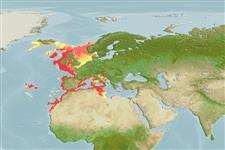Actinopterygii (ray-finned fishes) >
Perciformes (Perch-likes) >
Sparidae (Porgies)
Etymology: Pagellus: Diminutive of Latin, pager, derived from Greek, pagros = a fish, Dentex sp. (Ref. 45335).
Environment / Climate / Range
Ecology
Marine; benthopelagic; depth range 150 - 700 m (Ref. 56504), usually 150 - 300 m (Ref. 35388). Temperate, preferred 18°C (Ref. 107945); 65°N - 20°N, 32°W - 17°E
Eastern Atlantic: Norway, Strait of Gibraltar to Cape Blanc in Mauritania, Madeira, Canary Islands, and western Mediterranean (rare beyond the Sicilian Strait). Reported from Iceland (Ref. 12462).
Length at first maturity / Size / Weight / Age
Maturity: Lm 25.0 range ? - ? cm
Max length : 70.0 cm SL male/unsexed; (Ref. 4781); common length : 30.0 cm SL male/unsexed; (Ref. 4781); max. published weight: 4.0 kg (Ref. 9987); max. reported age: 15 years (Ref. 4645)
Inshore waters above various types of bottom (rocks, sand, mud) to 400 m (Mediterranean) and 700 m (Atlantic); young near the coast, adults on the continental slope specially over muddy bottoms. Omnivorous, but feed mainly on crustaceans, mollusks, worms and small fish. Protandric hermaphrodites, become females at 20-30 cm length. Adults move towards the coast up to the edge of the continental shelf to spawn from January to June (Ref. 3688). Important foodfish. Marketed fresh and frozen; consumed pan-fried, broiled and baked (Ref. 9987).
Protandric hermaphrodite species (male during its first sexual maturity). Becomes female between 2 and 7 years of age. Spawns from January to June, depending on latitude. Egg size 1.19 mm, larval length at hatching 3.7 mm. Simultaneous hermaphroditism is also suggested for this species (Ref. 103751).
Bauchot, M.-L. and J.-C. Hureau, 1990. Sparidae. p. 790-812. In J.C. Quero, J.C. Hureau, C. Karrer, A. Post and L. Saldanha (eds.) Check-list of the fishes of the eastern tropical Atlantic (CLOFETA). JNICT, Lisbon; SEI, Paris; and UNESCO, Paris. Vol. 2. (Ref. 3688)
IUCN Red List Status (Ref. 115185)
CITES (Ref. 94142)
Not Evaluated
Threat to humans
Harmless
Human uses
Fisheries: commercial; gamefish: yes
More information
ReferencesAquacultureAquaculture profileStrainsGeneticsAllele frequenciesHeritabilityDiseasesProcessingMass conversion
Tools
Special reports
Download XML
Internet sources
Estimates of some properties based on models
Phylogenetic diversity index (Ref.
82805): PD
50 = 0.5156 [Uniqueness, from 0.5 = low to 2.0 = high].
Bayesian length-weight: a=0.01230 (0.01071 - 0.01414), b=3.04 (3.01 - 3.07), in cm Total Length, based on LWR estimates for this species (Ref.
93245).
Trophic Level (Ref.
69278): 4.2 ±0.6 se; Based on diet studies.
Resilience (Ref.
69278): Low, minimum population doubling time 4.5 - 14 years (K=0.09-0.1; tmax=15; tm=4-5; Fec=70,000).
Prior r = 0.45, 2 SD range = 0.26 - 0.76, log(r) = -0.8, SD log(r) = 0.26, Based on: 13 K, 2 tgen, 3 tmax, 2 Fec records
Vulnerability (Ref.
59153): High vulnerability (57 of 100) .
